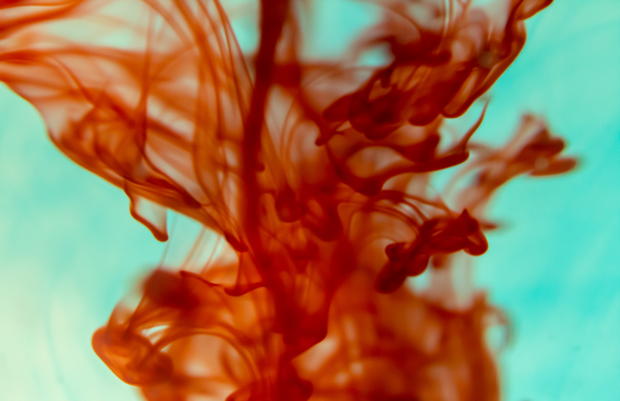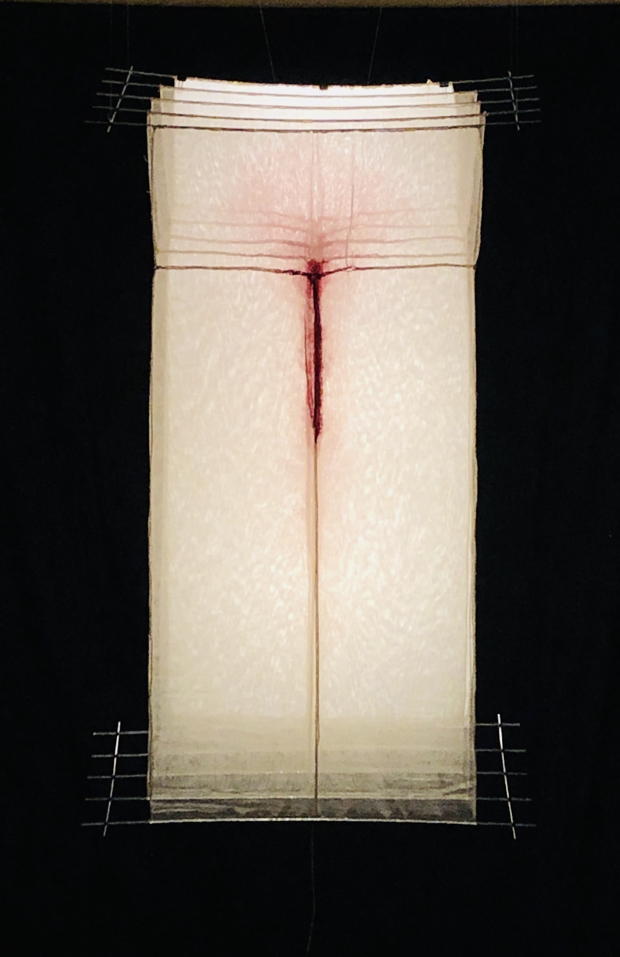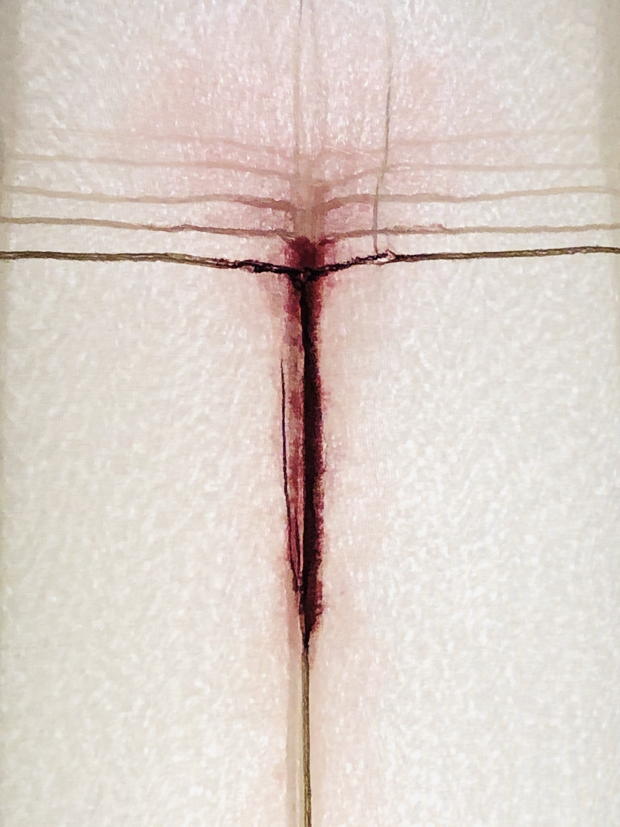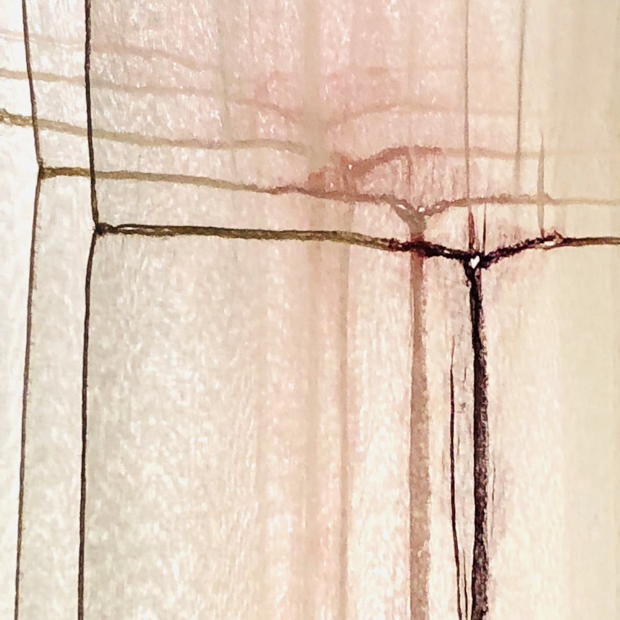
In this series, we invite you to join writers and artists in a practice of artistic Scriptural reflection.
Interpreting Scripture through art brings new insight to the fore through comparisons between textual details and elements of the artistic medium, as shaped by the artist. The art invites the viewer to draw out further insights based on the layers of comparison that their unique perspective brings, making artistic interpretation of Scripture a communal practice.
We suggest that with each devotional guide you first read the Scripture and take in the piece of art, then read the reflection, observe the piece again, and engage with the prompts for creative response. We also invite you to share your creative and reflective responses on social media and tag us. You can find us on Facebook (@tothewell), Instagram (@wap_ivcf), and Twitter (@IVWell).
Isaiah 53:5
But He was wounded for our transgressions,
He was bruised for our iniquities;
The chastisement for our peace was upon Him,
And by His stripes we are healed.
In this reflection, Leslie Iwai walks us around her meditation on Jesus’s scourging. The image is multiply allusive; the cross holds together violence, beauty, healing, and suffering.

Scourged.
Created to represent the sixth Station of the Cross, Scourged is an artwork that extends the moment of Jesus’s scourging. In the staccato shroud, each fragile fabric layer holds a microsecond in place to present its particular depth of violence and beauty.
I often create my work in layers, believing that a layered work has the potential to slow down one’s comprehension of an action, allowing the viewer to ruminate in the spaces between. Much like the stop motion photographs of a racehorse mid gallop, something so fast becomes extended frame by frame. When we handle fabric in daily life, we tear, sew, weave, and even pierce it. It wraps newborn babies and covers hospital beds, clothes royalty and bandages wounds. Fabric touches us in the most intimate ways.The layers of translucent fabric scrim in Scourged are a way to meditate on the connection between Jesus’s flesh and the fabric that touches it and to consider what these reveal about both his humanity and divinity. In this, we may deeply sense the promise that “by his stripes we are healed” (Isaiah 53:5).

In tenderness, healing and violence the clothes and fabric that touch Jesus’s body become metaphors for his own flesh. As a newborn he is first swaddled by his mother (Luke 2:7). The torn fabric strips cradle his fragile infant skin. Later, torn fabric strips are wrapped around his disfigured flesh in the tomb after his crucifixion (Mark 15:46).
Between these torn strips are also poignant moments of healing that seem even to imbue the garment that he wore. When he walks in a crowd, a woman touches his clothes with the faith that through her touch she will be healed. When Jesus feels power go out from him, he asks, “Who touched my clothes?” He affirms that her faith has made her well (Mark 5:24-34). As he continues ministering in the crowds, the word spreads about him and many more of the sick beg to touch only the hem of his garment and all who touch it are healed (Mark 14:35-36).
As the description of Jesus’s garments unfolds during his procession towards the cross, I wonder: Were these the same garments that multitudes touched to be healed? The way the soldiers divide and even rip Jesus’s clothing parallels the violence by which his body is degraded in torture and execution. The sound of ripping fabric, even the slightest tear in the knee of a pair of pants, can make one cringe; what about the rending of our Savior’s outer garments juxtaposed over the image of his scourged, battered flesh?
During this dividing of his clothing, there is another moment that becomes a strange counterpoint to the ripping of his outer garment. It feels out of place in the middle of the commotion, occurring when the soldiers see his seamless woven undergarment and they decide not to tear it but cast lots for it. The value of keeping this material whole shows the devaluing of Jesus’s body by comparison. The pause in this moment seems to save the ripping of the most intimate garment for last, and this is when I begin to sense the reality of his body being a temple (John 2:19-21). This inmost woven undergarment seems to parallel the heavily woven temple curtain that protects the Holy of Holies and is the last vestige of a physical division between God and his people.

In Scourged, the seams in each scrim layer form a progressive blood-red, ragged stripe, representing the tearing and scourging of our Lord’s flesh. From the horizontal seam, a crown emerges formed by his bloody, thorn-pierced brow. The vertical seam is a visual representation of the ripping of the temple curtain in two from top to bottom (Mark 15:38) as Jesus draws his last breath and dies. At this moment of audible and visual ferocity, I can’t help but think of a holy rending, a Father God rending — a sound of tearing that reverberates even unto this day.
However, the sound of that holy rending does not end in hopeless violence. Grief becomes the fabric for hope and healing, “and by his stripes” (Isaiah 53:5) has become a much richer moment to contemplate as I meditate on this connection between fabric and the body of our Lord. I am reminded and comforted that torn fabric is used for bandaging wounds and that Jesus invites us into the intimacy of his suffering and tender care through the curtain of his torn flesh (Hebrews 10:19-20). I am also filled with hope when thinking about how the linens that wrapped his corpse were laid aside in the tomb as his body was resurrected (John 20:6-7). These holy bandages, full of the healing and redemptive blood of our Savior, create a way for us to be wrapped, swaddled in his sacrifice, healed by his stripes, and brought close to his brave and tender heart.
Response: Layered Meditation (25-30 minutes)
- Pray. Contemplate Isaiah 53:5 and Leslie’s artwork, and describe to God what you observe.
- Reflect. If each line of Isaiah 53:5 is one “layer,” at what points do the layers match up? Where do you see parallelism? Synonyms? Antonyms?
- Create. Choose one verb and one noun from Isaiah 53:5. In an artistic medium of your choice, generate a simple representation for each. Then generate three “synonyms” and three “antonyms” in the same medium for each word. Arrange your eight elements in an order that makes sense to you.
- Reflect. Journal for five minutes and consider these questions. How did you choose to order your “synonyms” and “antonyms”? What does this say about the relationships among the elements? How does this affect the way you think about the meaning of the words you started with?
- Synthesis. Take one more moment to take note of an insight you’ve gained from this process. Pray that insight back to God.
Photo by Charlie Belvin Designs from StockSnap.